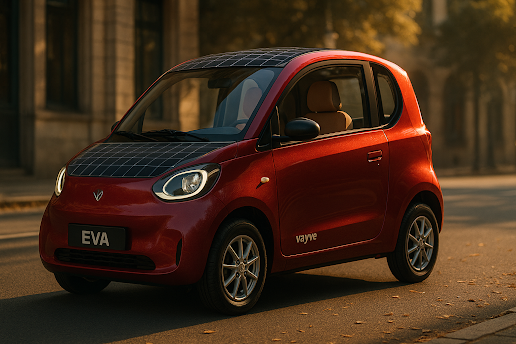India’s First Solar-Powered Car: Everything You Need to Know
India is stepping into a new era of green transportation with the introduction of its very first solar-powered car. As the world moves towards sustainable mobility, Indian engineers and automobile companies are not staying behind. With the rising cost of petrol and diesel, growing environmental concerns, and a strong push for renewable energy, solar-powered vehicles have started gaining momentum in the country.The concept of solar cars is not entirely new, but India finally has a real-world prototype that is both practical and futuristic. In this blog, we’ll walk you through everything you need to know about India’s first solar-powered car, how it works, who’s behind it, and why it matters.
India’s first solar car isn’t just a cool invention. It’s a symbol of innovation, sustainability, and a major leap forward in the automobile industry.
Who Built India’s First Solar Car?
The credit for designing India’s first fully solar-powered car goes to a passionate and determined engineer named Naveen Rabelli. A former automotive engineer, Naveen quit his job to build an affordable solar-powered vehicle that could run without fossil fuels. His car, named “Solar Tuk Tuk,” is a converted auto-rickshaw fitted with solar panels and lithium batteries. He even drove the vehicle from India to the UK to promote sustainable transport.
Since then, Indian startups and major companies have started exploring solar vehicle prototypes. Recently, a group of engineering students from Pune and a startup in Bengaluru introduced solar car models designed for Indian roads. These new models are being developed not just as experiments but for commercial launch in the near future.
How Does a Solar Car Work?
A solar-powered car works by converting sunlight into electricity using solar panels installed on its roof or body. These solar panels generate direct current (DC) electricity, which is stored in batteries. The stored power is then used to drive an electric motor, which propels the vehicle forward.
Unlike electric cars that need charging from the grid, solar cars can generate electricity on the move. This reduces the need for external charging, making them more convenient and cost-effective in the long run.
The major components in a solar-powered car include high-efficiency solar panels, a rechargeable lithium battery, a lightweight body, and an electric drivetrain. Most solar cars also come with backup charging options for cloudy days or night driving.
Features of India’s Solar Cars
The first-generation solar cars in India may not be luxury vehicles, but they offer several exciting features. These vehicles are designed to be light, compact, and energy efficient. On a full solar charge, some prototypes can travel up to 250 kilometers. The top speed varies from 40 to 80 km/h depending on the model.
Most of these vehicles come with digital dashboards, GPS navigation, regenerative braking, and basic comfort features like ventilation and power steering. While not yet suited for highways or high-speed racing, they are ideal for city commuting, rural areas, and eco-tourism.
Challenges in Solar Car Adoption
Despite their promise, solar-powered cars face a few practical challenges in India. One major issue is limited sunlight hours, especially during monsoon seasons. Another concern is the cost of high-efficiency solar panels, which are still expensive to mass produce.
Indian roads, traffic conditions, and the lack of infrastructure for solar-powered mobility pose further obstacles. But the biggest hurdle is awareness. Most people are still unaware that solar vehicles are a feasible and environment-friendly option for their daily travel.
To overcome these challenges, companies and the government need to work together. Investment in R&D, affordable manufacturing, and supportive policies are crucial to making solar-powered cars mainstream.
Why India Needs Solar Cars
India has one of the highest rates of air pollution in the world, with vehicles being a significant contributor. The country also imports a huge portion of its fuel, which affects the economy and energy security. Switching to solar vehicles can help tackle these issues while promoting green growth.
With over 300 sunny days a year, India has enormous solar potential. Solar-powered vehicles can tap into this resource to provide clean, silent, and zero-emission transport. They are especially useful for rural areas where access to charging stations is limited.
Solar cars can also reduce the load on the electricity grid, lower maintenance costs, and help families save money in the long run. They represent not just a technological innovation, but a practical solution to India’s growing environmental and energy problems.
The Road Ahead
The future of solar-powered cars in India looks promising. Major automobile players like Tata Motors and Mahindra are reportedly working on solar-integrated models. Government initiatives like FAME (Faster Adoption and Manufacturing of Hybrid and Electric Vehicles) are encouraging clean mobility options. In the next five to ten years, we may see solar cars becoming more common on Indian roads.
Solar technology is evolving rapidly. Panels are becoming more efficient, lightweight, and flexible. Combined with advancements in battery storage and smart vehicle systems, the next generation of solar cars will be safer, faster, and more practical for daily use.
In the meantime, India’s first solar cars serve as a bold reminder that clean energy is no longer a luxury. It’s a necessity. Whether it’s a small solar rickshaw or a full-sized sedan, every step toward sustainability counts.
Conclusion
India’s first solar-powered car is not just a product, it’s a movement. It shows what’s possible when creativity meets purpose. As the nation faces climate change, urban congestion, and fuel dependency, solar vehicles offer a ray of hope.
From passionate inventors to futuristic startups, the solar car revolution in India has begun. And while challenges remain, the direction is clear. The sun is shining on the future of mobility, and India is ready to drive forward.






.jpg)




